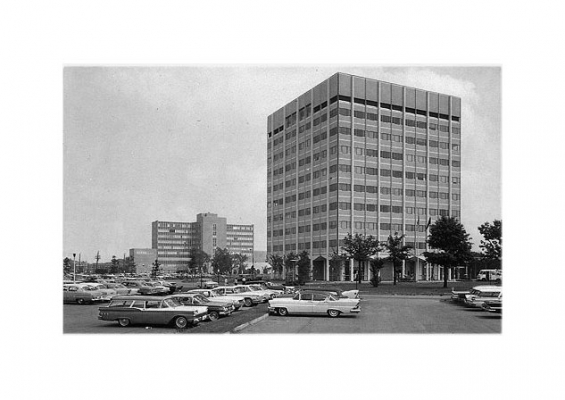When Dr. Harry Pariser began his career as a Dermatologist, the specialty of dermatology was actually known as “dermatology and syphilology” because of the historical importance of syphilis. In the era before accurate laboratory diagnosis was available, the interpretation of clinical signs, many of which involved the skin, were the only way to diagnose this important sexually transmitted disease. As a result, dermatologists became experts in syphilis, and, by extension, in all sexually transmitted diseases. Norfolk was therefore an attractive city for two reasons: there was only one dermatologist and there was considerable need for control of sexually transmitted diseases.
In 1946, Dr. Harry Pariser opened his practice. After a rocky start Dr. Pariser’s downtown Norfolk practice became an established feature of the medical community. Generally, he treated patients in his office, but also consulted at most of the area’s hospitals. When the Medical Tower opened in 1960, Dr. Pariser was among the original group of physicians and dentists who inaugurated this medical facility.
A series of significant changes transformed the practice in the mid 1970’s. In 1974, a second office location was established in the Kempsville area. In 1976, Dr. Pariser’s older son, David, joined the practice and introduced the element of dermatologic surgery. Two years later his younger brother, Robert, joined the practice, bringing in skills of dermatopathology. As time passed, additional physicians joined the practice, and more office locations were opened. Drs. Robert Baer, Linda Serwatka, Lawrence Chang, Molly Smith, Alan Rolfe, Cyndi Torosky, Kaija Hanneman and Kelly DeHart joined the practice later.
More striking than the changes in locations and personnel are the changes in the practice of medicine in general, and dermatology in particular, during the span of the practice. When Dr. Harry Pariser started his practice he had to deal with the full range of disorders of the skin, hair, and nails and with the complex area of sexually transmitted diseases without benefit of antibiotics (except sulfa drugs) or cortisone-related medications.
How things have changed! Dermatologic diagnosis today is infinitely more precise and is often based on specific findings in the laboratory or under the microscope to back up the skilled eye of the dermatologist. We have molecular diagnosis and are on the verge of understanding the genetic basis of many diseases. We are blessed with a large range of topical and systemic medications and sophisticated methods of light therapy. Many conditions can be cured, most can be controlled, and a few defy the best modern medicine can currently offer. Highly specific bioengineered medications are in use or under study. The fields of dermatopathology, immunodermatology, dermatologic surgery and pediatric dermatology are well established. We have over 100 employees. And, for better or worse, we have medical insurance.
The practice of medicine in general, and dermatology in particular, is much more complex and challenging than it was in 1946. Advances unimaginable at that time are taken for granted today, but the complexity and frustrations of a medical practice have also increased. Despite the advances and the annoyances, the basics remain the same. The physicians and staff of Pariser Dermatology Specialists strive to employ the science of dermatologic medicine and surgery in the finer art of helping people deal with and prevent the disorders that afflict the skin, hair, and nails.





